Parameter-Gain Accelerated ZNN Model for Solving Time-Variant Nonlinear Inequality-Equation Systems and Application on Tracking Symmetrical Trajectory
Abstract
1. Introduction
- For settling the time-variant NIE systems effectively, an equivalent transformation is explored, and the PGAZNN model is proposed, which is the main novelty of this paper.
- A time-variant parameter-gain function and a nonlinear SBP-AF are explored in the PGAZNN model. The stability and finite time convergence of the PGAZNN model are proved through rigorous mathematical analysis, and the upper bound of the convergence time is obtained.
- Simulation example verifies the effectiveness and superiority of the PGAZNN model after equivalent conversion in settling time-variant NIE systems. The practical application of Symmetrical trajectory tracking further confirms the superior performance of the PGAZNN model.
2. Problem Descriptions and Transformation
2.1. Time-Variant NIE Systems
2.2. Equivalent Transformation
3. PGAZNN Model
- (1)
- Linear AF:
- (2)
- Power type AF:
- (3)
- Bipolar-sigmoid type AF:
- (4)
- Power-sigmoid type AF:
4. Theoretical Testimony and Analysis
4.1. Stability Analysis
4.2. Convergence Analysis
5. Numerical Simulation
5.1. Numerical Example
5.2. Application
6. Conclusions
Author Contributions
Funding
Data Availability Statement
Conflicts of Interest
Abbreviations
| NIE | nonlinear inequality and equation |
| ZNN | zeroing neural network |
| PGAZNN | parameter-gain accelerated zeroing neural network |
| TSBP-AF | tunable sign-bi-power activation function |
References
- Chen, Y.; Yang, B.; Dong, J. Nonlinear system modelling via optimal design of neural trees. Int. J. Neural Syst. 2004, 14, 125–137. [Google Scholar] [CrossRef]
- Zhang, H.; Qin, C.; Luo, Y. Neural-network-based constrained optimal control scheme for discrete-time switched nonlinear system using dual heuristic programming. IEEE Trans. Autom. Sci. Eng. 2014, 11, 839–849. [Google Scholar] [CrossRef]
- Xiao, L.; Liao, B.; Li, S.; Chen, K. Nonlinear recurrent neural networks for finite-time solution of general time-varying linear matrix equations. Neural Netw. 2018, 98, 102–113. [Google Scholar] [CrossRef]
- Xiao, L.; Zhang, Z.; Li, S. Solving time-varying system of nonlinear equations by finite-time recurrent neural networks with application to motion tracking of robot manipulators. IEEE Trans. Syst. Man Cybern. Syst. 2018, 49, 2210–2220. [Google Scholar] [CrossRef]
- Zhang, Y.; Yang, M.; Huang, H.; Xiao, M.; Hu, H. New discrete-solution model for solving future different-level linear inequality and equality with robot manipulator control. IEEE Trans. Ind. Inform. 2018, 15, 1975–1984. [Google Scholar] [CrossRef]
- Zhang, Y. A set of nonlinear equations and inequalities arising in robotics and its online solution via a primal neural network. Neurocomputing 2006, 70, 513–524. [Google Scholar] [CrossRef]
- Tan, Z.; Li, W.; Xiao, L.; Hu, Y. New varying-parameter znn models with finite-time convergence and noise suppression for time-varying matrix moore–penrose inversion. IEEE Trans. Neural Netw. Learn. Syst. 2019, 31, 2980–2992. [Google Scholar] [CrossRef] [PubMed]
- N’Doye, I.; Darouach, M.; Voos, H. Observer-based approach for fractional-order chaotic synchronization and communication. In Proceedings of the 2013 European Control Conference (ECC), Zurich, Switzerland, 17–19 July 2013; pp. 4281–4286. [Google Scholar]
- Rahimilarki, R.; Gao, Z.; Zhang, A.; Binns, R. Robust neural network fault estimation approach for nonlinear dynamic systems with applications to wind turbine systems. IEEE Trans. Ind. Inform. 2019, 15, 6302–6312. [Google Scholar] [CrossRef]
- Li, Z.; Li, C.; Li, S.; Cao, X. A Fault-tolerant method for motion planning of industrial redundant manipulator. IEEE Trans. Ind. Inform. 2019, 16, 7469–7478. [Google Scholar] [CrossRef]
- Topcu, U.; Packard, A. Local stability analysis for uncertain nonlinear systems. IEEE Trans. Autom. Control 2009, 54, 1042–1047. [Google Scholar] [CrossRef]
- Vannelli, A.; Vidyasagar, M. Maximal lyapunov functions and domains of attraction for autonomous nonlinear systems. Automatica 1985, 21, 69–80. [Google Scholar] [CrossRef]
- Chen, D.; Li, S.; Wu, Q. A Novel supertwisting zeroing neural network with application to mobile robot manipulators. IEEE Trans. Neural Netw. Learn. Syst. 2020, 32, 1776–1787. [Google Scholar] [CrossRef]
- Zhang, Y.; Li, S.; Weng, J.; Liao, B. GNN model for time-varying matrix inversion with robust finite-time convergence. IEEE Trans. Neural Netw. Learn. Syst. 2022, 35, 559–569. [Google Scholar] [CrossRef] [PubMed]
- Zhang, Z.; He, Y.; Mai, W.; Luo, Y.; Li, X.; Cheng, Y.; Huang, X.; Lin, R. Convolutional dynamically convergent differential neural network for brain signal classification. IEEE Trans. Neural Netw. Learn. Syst. 2024, 36, 8166–8177. [Google Scholar] [CrossRef]
- Jin, J.; Chen, W.; Ouyang, A.; Yu, F.; Liu, H. A time-varying fuzzy parameter zeroing neural network for the synchronization of chaotic systems. IEEE Trans. Emerg. Top. Comput. 2024, 8, 364–376. [Google Scholar] [CrossRef]
- Jin, J.; Wu, M.; Ouyang, A.; Li, K.; Chen, C. A novel dynamic hill cipher and its applications on medical IoT. IEEE Internet Things J. 2025, 12, 14297–14308. [Google Scholar] [CrossRef]
- Zhang, Y.; Ge, S. Design and analysis of a general recurrent neural network model for time-varying matrix inversion. IEEE Trans. Neural Netw. 2005, 16, 1477–1490. [Google Scholar] [CrossRef]
- Li, J.; Qu, L.; Yueming, Z.; Zhan, L.; Bolin, L. A novel zeroing neural network for time-varying matrix pseudoinverse in the presence of linear noise. Tsinghua Sci. Technol. 2025, 30, 1911–1926. [Google Scholar] [CrossRef]
- Cao, S.; Jin, J.; Zhang, D.; Chen, C. A review of Zeroing neural network: Theory, algorithm and application. Neurocomputing 2025, 643, 130425. [Google Scholar] [CrossRef]
- Xiao, L.; Li, L.; Tao, J.; Li, W. A predefined-time and anti-noise varying-parameter ZNN model for solving time-varying complex Stein equations. Neurocomputing 2023, 526, 158–168. [Google Scholar] [CrossRef]
- Tang, Z.; Zhang, Y. Continuous and discrete gradient-Zhang neuronet (GZN) with analyses for time-variant overdetermined linear equation system solving as well as mobile localization applications. Neurocomputing 2023, 561, 126883. [Google Scholar] [CrossRef]
- Xiao, L.; He, Y.; Dai, J.; Liu, X.; Liao, B.; Tan, H. A variable-parameter noise-tolerant zeroing neural network for time-variant matrix inversion with guaranteed robustness. IEEE Trans. Neural Netw. Learn. Syst. 2020, 33, 1535–1545. [Google Scholar] [CrossRef]
- Dai, J.; Yang, X.; Xiao, L.; Jia, L.; Li, Y. ZNN with fuzzy adaptive activation functions and its application to time-varying linear matrix equation. IEEE Trans. Ind. Inform. 2021, 18, 2560–2570. [Google Scholar] [CrossRef]
- Xiao, L.; Liu, S.; Wang, X.; He, Y.; Jia, L.; Xu, Y. Zeroing neural networks for dynamic quaternion-valued matrix inversion. IEEE Trans. Ind. Inform. 2021, 18, 1562–1571. [Google Scholar] [CrossRef]
- Xiao, L.; Li, X.; Huang, W.; Jia, L. Finite-time solution of time-varying tensor inversion by a novel dynamic-parameter zeroing neural-network. IEEE Trans. Ind. Inform. 2021, 18, 4447–4455. [Google Scholar] [CrossRef]
- Luo, J.; Yang, H. New variant-parameter ZNN solutions for resolving time-variant plural lyapunov equation under preassigned time. IEEE Trans. Ind. Inform. 2022, 19, 6482–6491. [Google Scholar] [CrossRef]
- Liu, M.; Zhang, S.; Chen, H.; Sheng, W. H∞ output tracking control of discrete-time nonlinear systems via standard neural network models. IEEE Trans. Neural Netw. Learning Syst. 2014, 25, 1928–1935. [Google Scholar] [CrossRef]
- Miao, P.; Shen, Y.; Huang, Y.; Wang, Y.-W. Solving time-varying quadratic programs based on finite-time Zhang neural networks and their application to robot tracking. Neural Comput. Appl. 2014, 26, 693–703. [Google Scholar] [CrossRef]
- Li, Y.; Liu, Y.; Tong, S. Observer-based neuro-adaptive optimized control of strict-feedback nonlinear systems with state constraints. IEEE Trans. Neural Netw. Learn. Syst. 2021, 33, 3131–3145. [Google Scholar] [CrossRef]
- Zhu, J.; Jin, J.; Chen, C.; Wu, L.; Lu, M.; Ouyang, A. A new-type zeroing neural network model and its application in dynamic cryptography. IEEE Trans. Emerg. Top. Comput. 2025, 9, 176–191. [Google Scholar] [CrossRef]
- Xiao, L.; Zhang, Y. Neural network versus gradient neural network for solving time-varying linear inequalities. IEEE Trans. Neural Netw. 2011, 22, 1676–1684. [Google Scholar] [CrossRef] [PubMed]
- Xiao, L.; He, Y.; Liao, B.; Dai, J. An accelerated ZNN-based algorithm with piecewise time-varying parameters to solve time-variant linear equations. J. Comput. Appl. Math. 2021, 398, 113665. [Google Scholar] [CrossRef]
- Zeng, Y.; Li, K.; Xiao, L.; Liao, Q. Design and analysis of a novel integral design scheme for finding finite-time solution of time-varying matrix inequalities. IEEE Trans. Emerg. Top. Comput. 2020, 10, 267–279. [Google Scholar] [CrossRef]
- Xiao, L.; Cao, Y.; Dai, J.; Jia, L.; Tan, H. Finite-time and predefined-time convergence design for zeroing neural network: Theorem, method, and verification. IEEE Trans. Ind. Inform. 2020, 17, 4724–4732. [Google Scholar] [CrossRef]
- Yu, F.; Liu, L.; Xiao, L.; Li, K.; Cai, S. A robust and fixed-time zeroing neural dynamics for computing time-variant nonlinear equation using a novel nonlinear activation function. Neurocomputing 2019, 350, 108–116. [Google Scholar] [CrossRef]
- Li, W.; Su, Z.; Tan, Z. A variable-gain finite-time convergent recurrent neural network for time-variant quadratic programming with unknown noises endured. IEEE Trans. Ind. Inform. 2019, 15, 5330–5340. [Google Scholar] [CrossRef]
- Ge, S.S.; Hang, C.C.; Lee, T.H.; Zhang, T. Stable Adaptive Neural Network Control; Springer Science & Business Media: Berlin/Heidelberg, Germany, 2013. [Google Scholar]
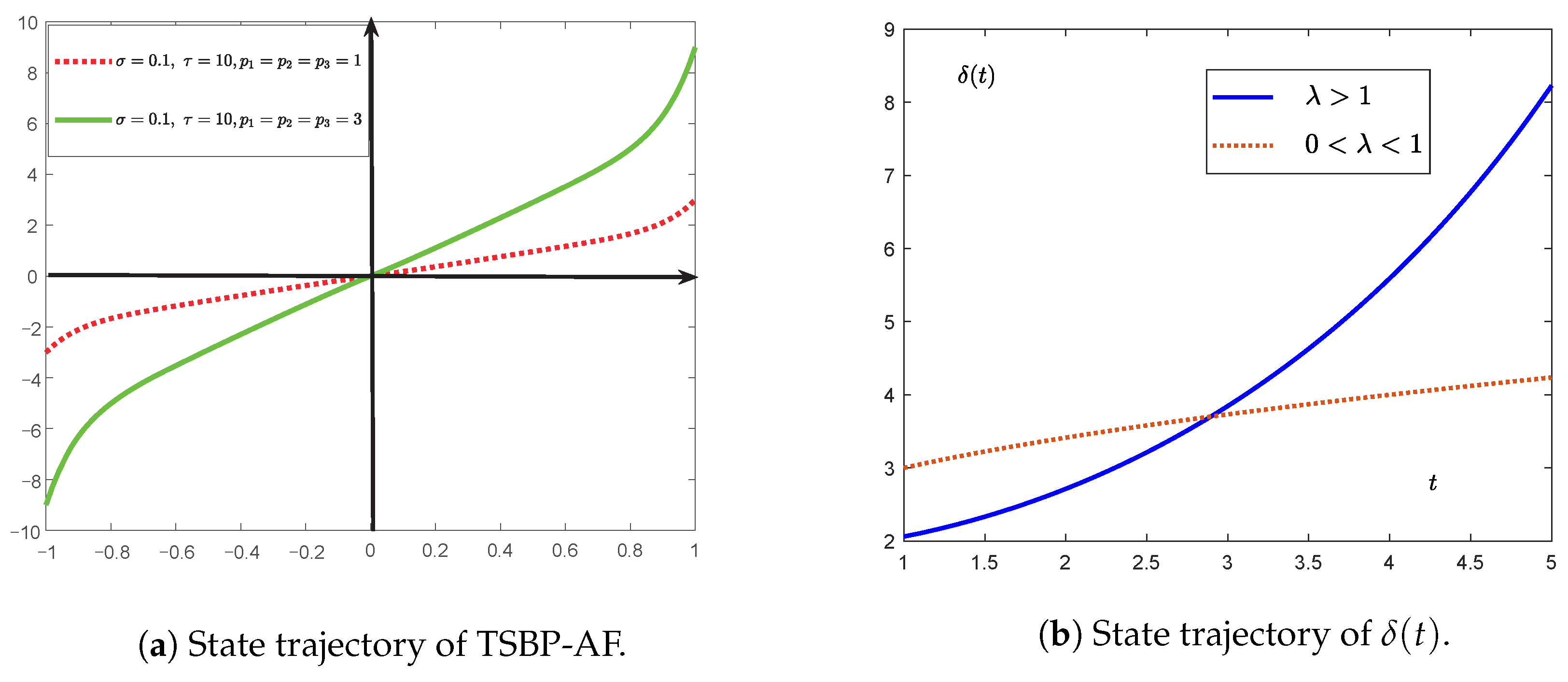

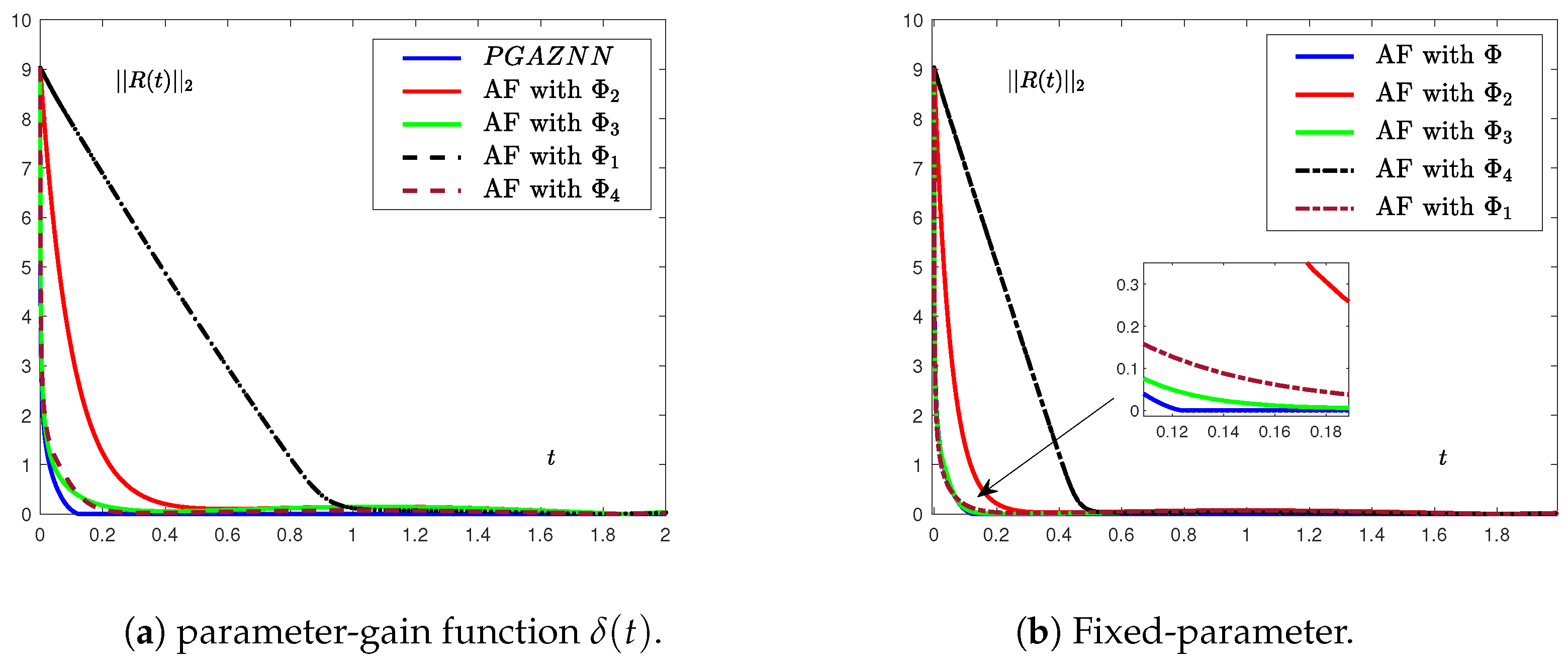
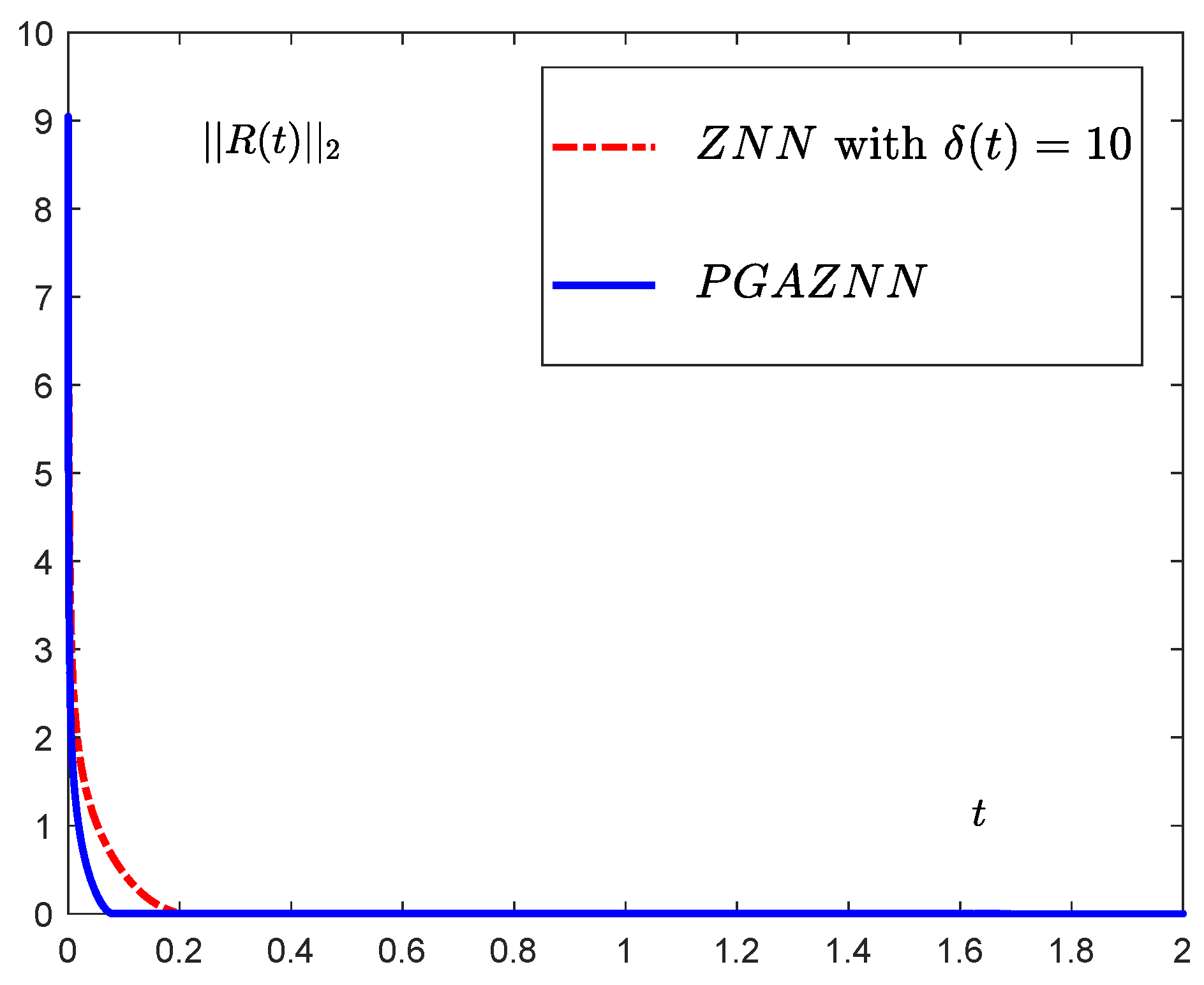
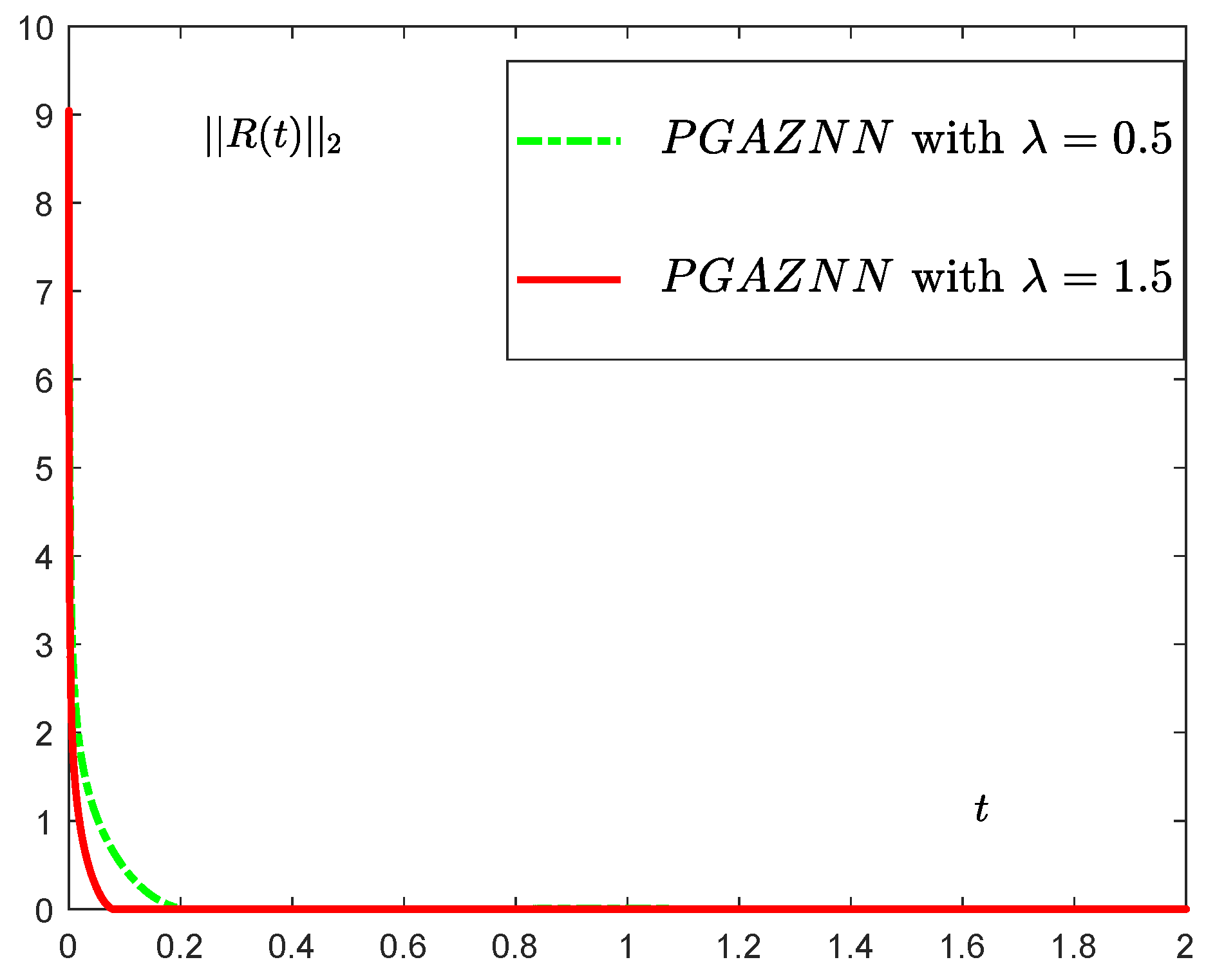
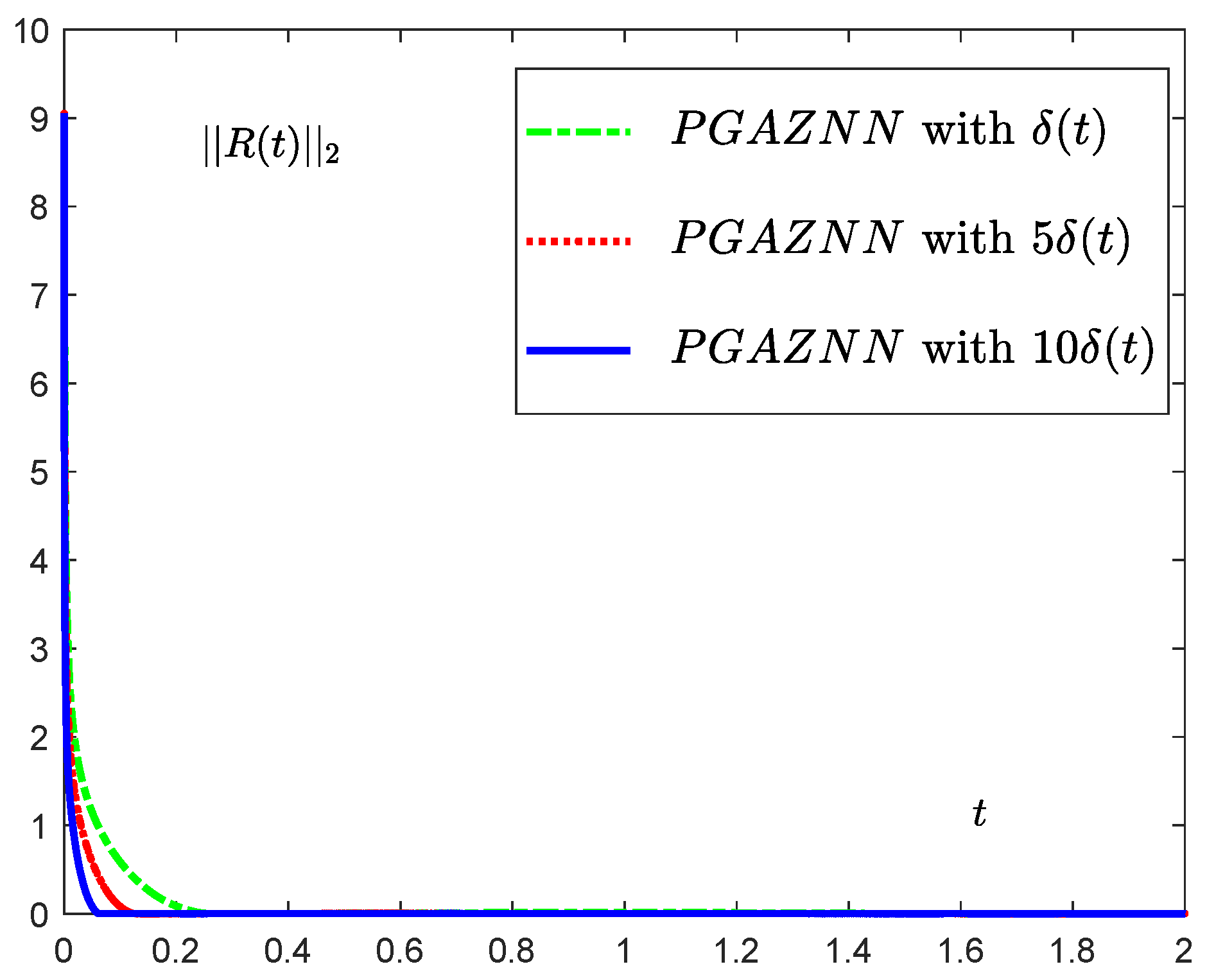
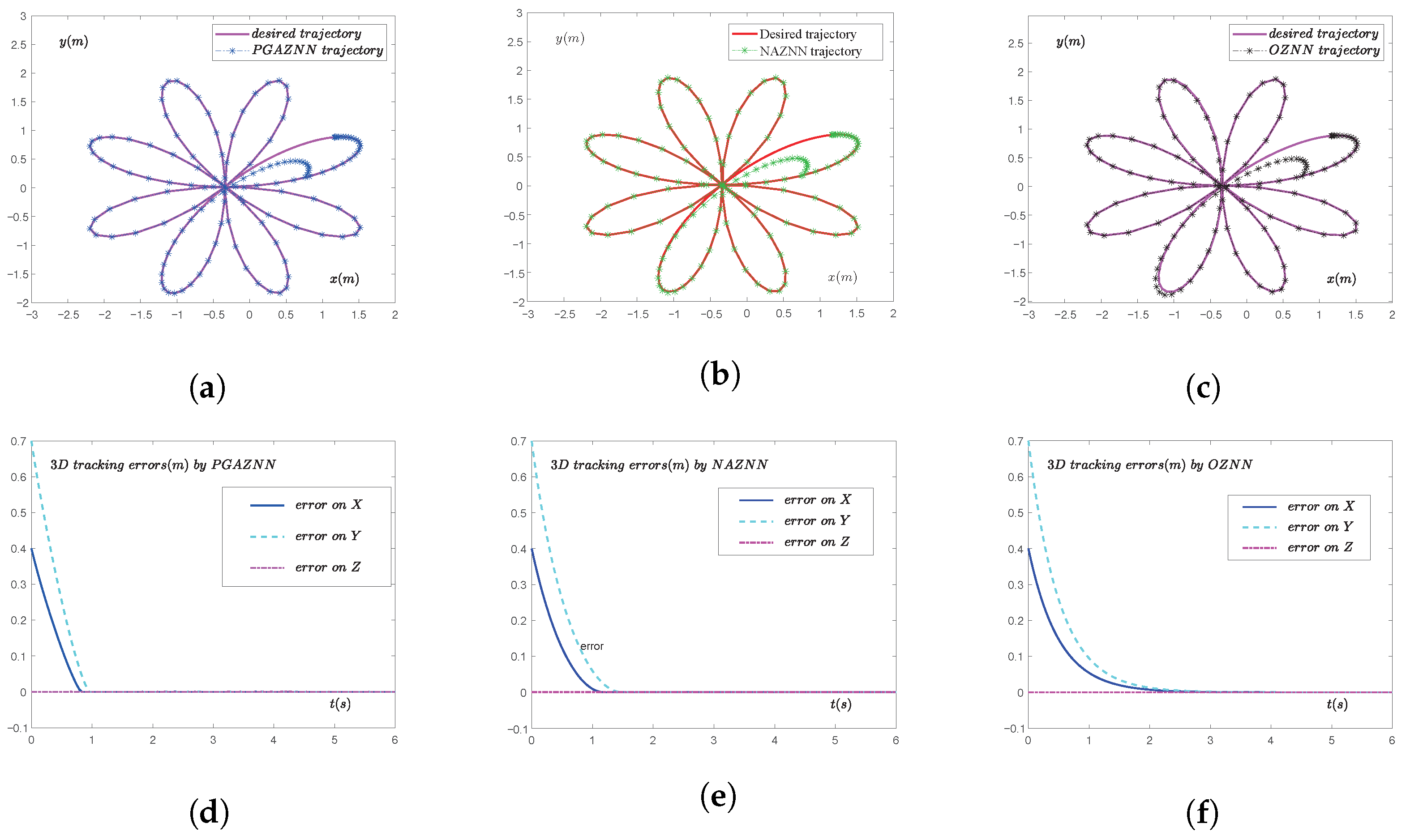
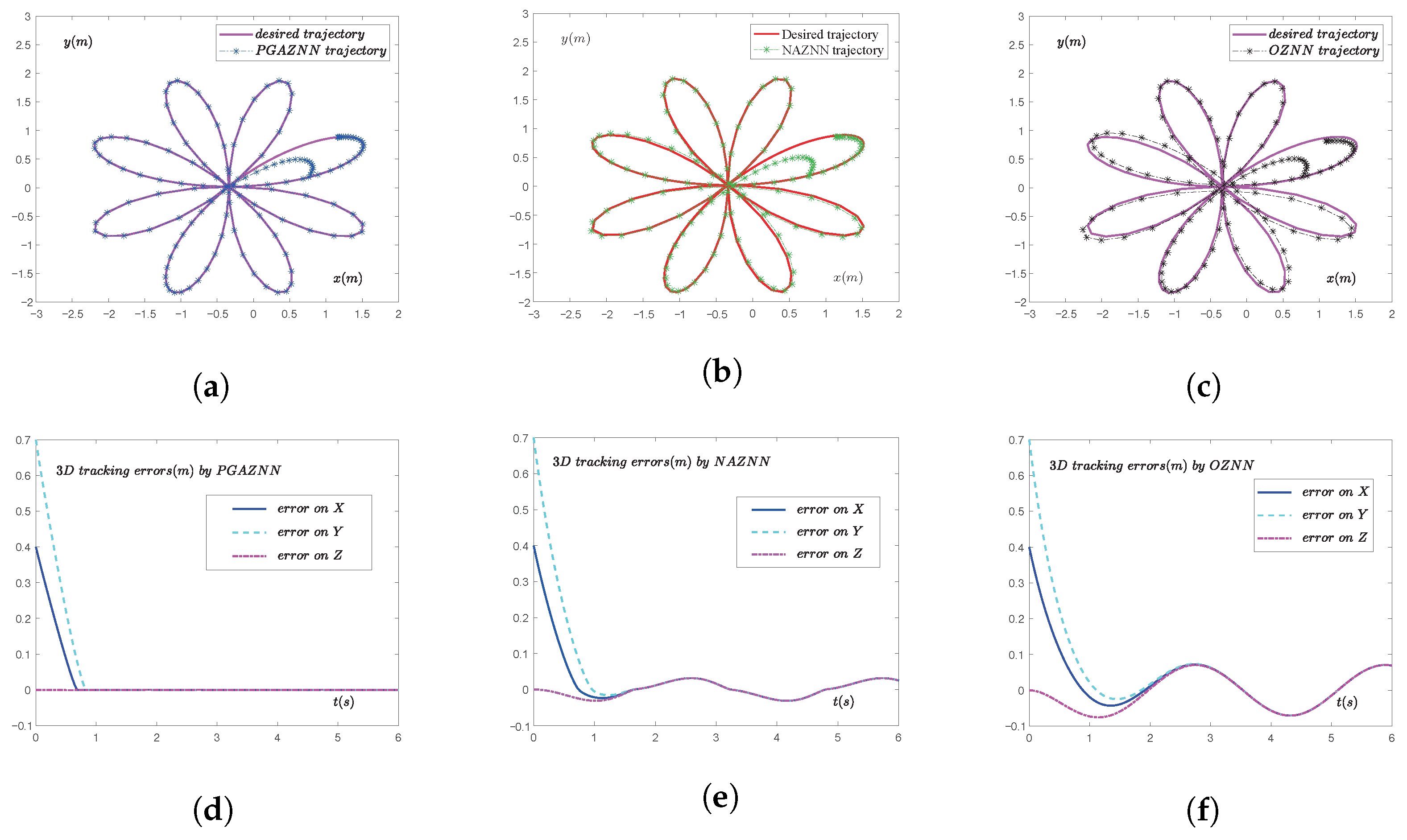
| Model | GAZNN | NAZNN | OZNN |
|---|---|---|---|
| 1.04 | 1.47 | 2.89 |
Disclaimer/Publisher’s Note: The statements, opinions and data contained in all publications are solely those of the individual author(s) and contributor(s) and not of MDPI and/or the editor(s). MDPI and/or the editor(s) disclaim responsibility for any injury to people or property resulting from any ideas, methods, instructions or products referred to in the content. |
© 2025 by the authors. Licensee MDPI, Basel, Switzerland. This article is an open access article distributed under the terms and conditions of the Creative Commons Attribution (CC BY) license (https://creativecommons.org/licenses/by/4.0/).
Share and Cite
Lei, Y.; Xu, L.; Chen, J. Parameter-Gain Accelerated ZNN Model for Solving Time-Variant Nonlinear Inequality-Equation Systems and Application on Tracking Symmetrical Trajectory. Symmetry 2025, 17, 1342. https://doi.org/10.3390/sym17081342
Lei Y, Xu L, Chen J. Parameter-Gain Accelerated ZNN Model for Solving Time-Variant Nonlinear Inequality-Equation Systems and Application on Tracking Symmetrical Trajectory. Symmetry. 2025; 17(8):1342. https://doi.org/10.3390/sym17081342
Chicago/Turabian StyleLei, Yihui, Longyi Xu, and Jialiang Chen. 2025. "Parameter-Gain Accelerated ZNN Model for Solving Time-Variant Nonlinear Inequality-Equation Systems and Application on Tracking Symmetrical Trajectory" Symmetry 17, no. 8: 1342. https://doi.org/10.3390/sym17081342
APA StyleLei, Y., Xu, L., & Chen, J. (2025). Parameter-Gain Accelerated ZNN Model for Solving Time-Variant Nonlinear Inequality-Equation Systems and Application on Tracking Symmetrical Trajectory. Symmetry, 17(8), 1342. https://doi.org/10.3390/sym17081342





